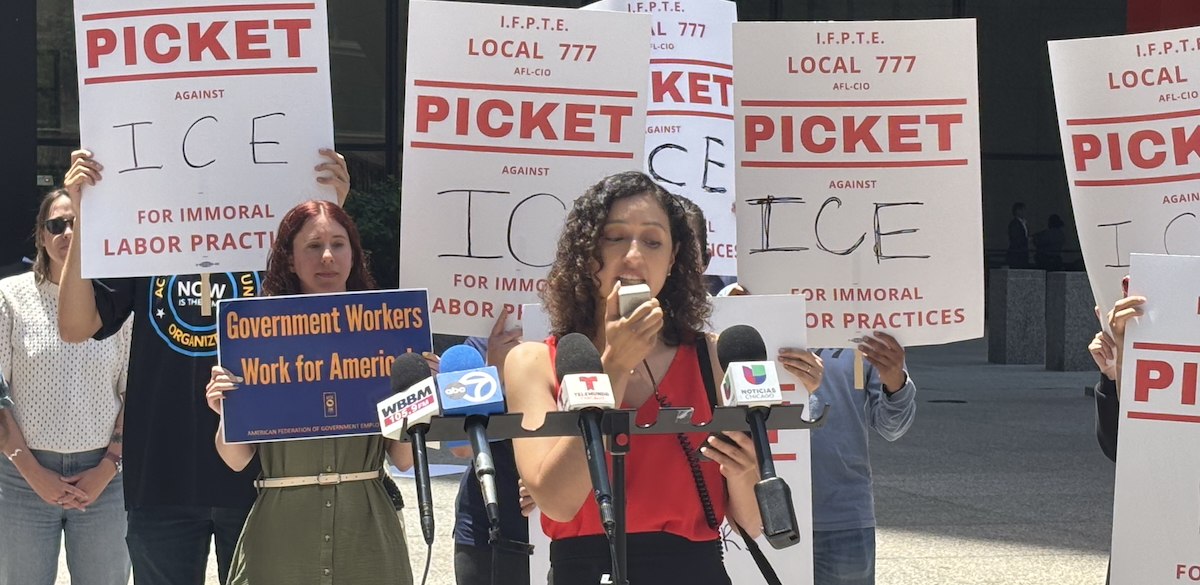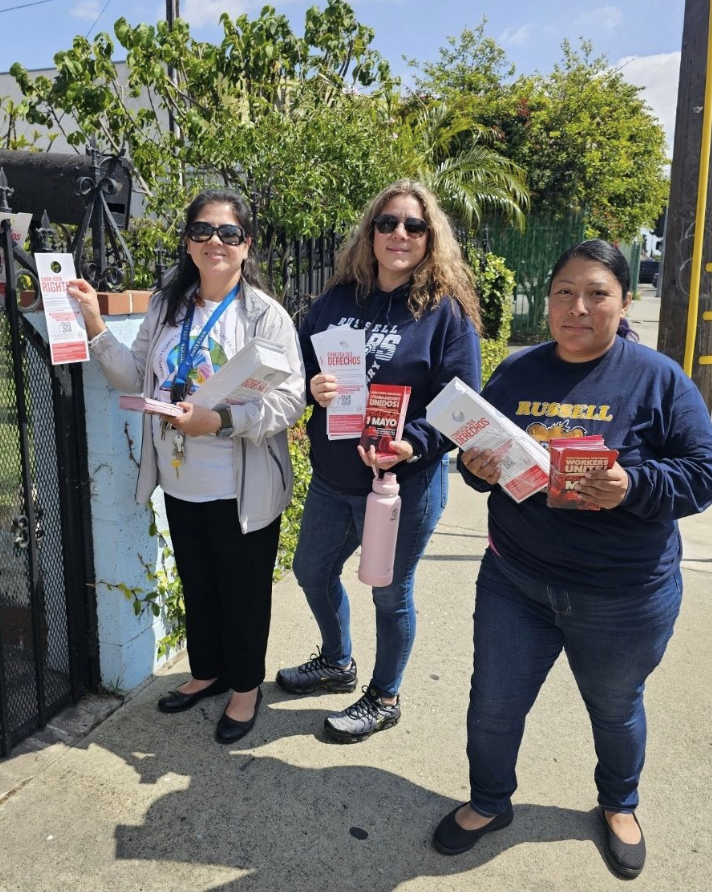Fight ICE. Build the Union.

IFPTE Local 777 members rallied in Chicago on June 25 demanding an end to ICE in federal workplaces. Photo: Colin Smalley
It was the morning of June 9, and Genie Kastrup, president of Service Employees Local 1, stood in front of Chicago’s Daley Plaza and bellowed into a microphone. “What is happening right now is about silencing voices,” she said, flanked by members of her union holding signs that read “Free David Huerta.”
“It's about dividing working people,” she continued. “It's about dividing our communities against the have and have nots. It is abusing power.”
The demonstration was one of 37 taking place that day across the country to protest the June 6 Immigration and Customs Enforcement (ICE) assault and detention of Huerta, the president of SEIU California and SEIU-United Service Workers West. Huerta had shown up to defend members of his Los Angeles community from federal raids. Images of the long-time labor leader with his head pressed to a curb by ICE agents touched off anger—and mobilization. Huerta was released after three days and hit with charges of felony conspiracy.
Facing an emboldened Trump administration, union members across the country are in an intensifying battle to keep their members—and all workers, whether or not they are in unions—free and safe from federal immigration authorities. They are holding emergency rallies, organizing in their workplaces, knocking doors in their communities, using contracts to defend members, and building coalitions that can respond rapidly to detentions and raids.
While unions cannot guarantee workers’ safety, many are mobilizing to protect them against an administration that is increasingly targeting workplaces and labor leaders themselves.
“We’re on the line, we’re targets,” Minnesota AFL-CIO President Bernie Burnham said about labor leaders and organizers. It was June 9, and she was addressing a rally on the steps of the Minnesota State Capitol in St. Paul. “They’ll come after anybody if you disagree with them. I think it’s just a matter of time. Watch where you’re at. You’re stronger in numbers than you are on your own.”
David Huerta is not the only unionist who has been targeted by ICE. At least three other people affiliated with SEIU were also recently detained, though have since been freed: Lewelyn Dixon, a member of SEIU 925; Rümeysa Öztürk, a member of SEIU Local 509; and Cliona Ward, a member of SEIU 2015. Alfredo “Lelo” Juarez Zeferino, a farmworker and leader in the militant union Familias Unidas por la Justicia, is still in detention, as is Kilmar Abrego Garcia, a member of SMART Local 100, and Maximo Londonio, a member of Machinists (IAM) Local Lodge 695.
The vast majority of workers targeted by ICE have no union. They are day laborers, textile workers, and caregivers, or work in other parts of the informal economy.
But some unions are mobilizing to defend not only their own members, but non-union workers and communities that are under attack. SEIU, for example, is calling for an end to “the brutal ICE raids terrorizing our neighborhoods and tearing families apart.” This points to the underlying reality: Whether the Trump administration is targeting labor leaders or workers who are perceived to be powerless and unable to fight back, their attacks intimidate workers and undermine their fights for better wages and conditions.
At events across the country, union leaders and members have emphasized that detaining workers—whether or not they are union members—is unjust. But the Trump administration’s targeting of organized labor might reveal something about how it is trying to consolidate power.
“It’s not a surprise to me that a fascist government starts their crackdown by going after labor first, undocumented workers, and going into work sites,” Sheigh Freeberg, secretary-treasurer of UNITE HERE 17 told the crowd in St. Paul. Freeberg’s union represents hospitality and food service workers in Minnesota. “They know the real power in this country is labor, and they’re afraid of us.”
‘KIDNAPPED OFF THE STREET’
On June 30, SEIU members and Starbucks baristas gathered from across the country to protest outside of the Central Louisiana ICE Processing Center. “We cannot wait for things to be happening to us to start fighting, because when we wait for that level, then we’re left with no one to fight with,” said Siti Pulcheon, a barista and shift supervisor who attended the demonstration.
In response to immigration raids across the country, Starbucks Workers United recently offered a Know Your Rights training open to all Starbucks baristas. “A lot of really important questions were asked, like ‘How can we protect not just the baristas in our store, but also our customers?’” Pulcheon said.
The Trump administration has portrayed its widening ICE dragnet as targeting dangerous criminals, but that has turned out to mean legal permanent residents with traffic citations, nonviolent crimes committed 20 years ago (like Londonio), misdemeanors like vending too close to the curb, or no record at all. And with no opportunity for detainees to make a case before a judge, and an ICE quota of 3,000 arrests a day, no one is safe.
“Anybody who thinks we have to ignore certain issues or avoid certain political conversations in order to grow the base, they don’t understand what it means to grow the base,” said Ryan Andrews, an English teacher and member of the United Teachers of Los Angeles (UTLA). Organizing around immigrant justice has actually pushed some members to engage more closely with their union, he said.
Andrews pointed to a student walkout in February protesting President Trump’s immigration policies. After protesting students were assaulted by two adult men, teachers and students met to discuss a path forward. Teachers circulated a petition demanding that the district denounce the attacks, meet with students and their families when attacked, ensure the safety of students at student-led actions, and provide mental health resources for affected students.
“Almost every co-worker signed the petition,” Andrews said, including those who felt left behind by their union. “After careful organizing conversations, those co-workers signed because they care about their students and are open to perspectives that differ from their own.”
Andrews' union is now building on past contract wins. UTLA’s 2019 strike resulted in the creation of an immigrant defense fund. Workers are now trying to further expand collective defense, said Andrews: They’re fighting to protect members who need to take a leave due to their immigration status and pushing the district to invest in legal and mental health support for immigrant students.
MOBILIZING AGAINST THE RAIDS
Beyond organizing on the job, workers are joining mass mobilizations in the streets. UTLA members have been canvassing their neighborhoods with door hangers informing residents of their rights if ICE agents come to the door. “Teachers are connected to the very fabric of the communities where we work,” Andrews said. “These things are not abstractions. We are seeing our students and their family members kidnapped off the street.”

Workers in major cities across the country are organizing against workplace raids. After the Trump administration set an aggressive new quota late May demanding that ICE officers arrest 3,000 people per day, agents began flooding federal buildings, said Ben Mabie, a staffer with IFPTE Local 98 in New York City. “It was horrific to watch the [lack of] of personal dignity [afforded to] the people that were getting caught up, and it was also a really grave safety issue. These people weren’t identifying themselves as law enforcement,” he said.
On June 25, federal workers in New York, Chicago, and Seattle held informational pickets demanding an end to ICE’s workplace raids.
“It is a profound attack on our civil institutions,” said Colin Smalley, president of IFPTE Local 777 and a co-founder of the Federal Unionists Network who attended the ICE OUT demonstration in Chicago.
Smalley’s job at the Army Corps of Engineers is to ensure environmental compliance. He said that ICE’s presence in federal buildings affects his work: “If we have ICE agents that are conducting these raids without identification, without showing their face, without warrants, that makes it more risky for me to do my job,” he said. “If folks feel like submitting a permit application to us makes it more likely that they’ll get targeted in a raid, they’re not going to do it. Then, by not engaging in our permit process, they are less likely to do the work in a way that balances the needs of economic development with the best practices for environmental protection.” Smalley stressed that he was not speaking on behalf of his employer.
UNIONS FIGHT FOR IMMIGRANT WORKERS
Even as the Trump administration cracks down on immigrant workers, union members continue to face the day-to-day challenges of organizing against the boss and fighting for a good contract. And sometimes that includes fighting to protect immigrants in the workforce.
More than 100 Teamsters Local 705 members at Mauser Packaging Solutions in Chicago are on strike, supported by fellow union members in Los Angeles and Minnesota. Protections for immigrant workers are part of what they are fighting for. The Chicago workers want contract language that protects immigrant workers from intimidation, modeled on language Seattle workers won three years ago. "Local 705 is fighting to win similar protections for our immigrant brothers and sisters that live in the very community where Mauser's Chicago facility is located," reads a press statement from the local.

SUPPORT LABOR NOTES
BECOME A MONTHLY DONOR
Give $10 a month or more and get our "Fight the Boss, Build the Union" T-shirt.
In Chicago, labor, community groups, and workers’ centers have been holding “Know Your Rights” trainings since before the Trump administration came to power, prompting Trump’s “border czar,” Tom Homan, to complain in late January that Chicagoans were too well educated “on how to defy ICE.”
This work is more critical than ever, says Shelly Ruzicka, communications director for Arise Chicago, a workers' center. “One of the biggest things we're telling people is to be informed and be connected,” Ruzicka explains. “Know what your rights are, have conversations with your family, and practice so that if there is an altercation, you are prepared.”
CHICAGO’S COORDINATED RESPONSE
The Trump administration has repeatedly threatened to target Chicago, because it is a sanctuary city, where laws restrict collaboration between the police department and ICE. Labor has been part of the effort to defend the city’s sanctuary status, established in the 2006 Welcoming City Ordinance, against recent attempts to weaken its provisions.
Chicago has an extensive network of labor and community groups that rapidly respond to the presence of immigration authorities in the city. “We are trying to deepen and strengthen our capacity to do coalition work here in Chicago,” said Jackson Potter, the vice president of the Chicago Teachers Union (CTU). “Labor and the community are coordinating responses to ICE in real time, because the attacks are becoming heightened, and putting a drain on our existing infrastructure and resources.” The coalition includes elected leaders, like Alderman Byron Sigcho Lopez, who serves in the 25th Ward, often a port of entry for migrants and refugees.
In recent months, these coalitions have been tested—labor has had to quickly mobilize in response to reports of ICE. In late February, parents reported that they had “witnessed law enforcement agents… arrest a father in front of his children as he dropped them off for school at Idar Elementary,” according to a CTU press release. Parents had already been planning to hold a vigil to oppose the proposed closure of three schools. But after the alleged detention, the vigil expanded to incorporate opposition to ICE, and CTU members and elected officials joined in the demonstration February 26.
Potter said that the rally was intended to provide a layer of safety in case ICE carried out more raids in the area. “We had multiple conversations with a number of moms expressing fear, and they decided along with us that we should move forward to make sure people felt defended and protected in this terrifying incident and the aftermath,” he said.
“I don’t care what agency they turn out to be, targeting a father as he tries to provide an education to his children at their place of learning is a deliberate act of terror on behalf of this government,” said CTU President Stacy Davis Gates in a press statement about the vigil. “Chicagoans have already shown that we are who keep each other safe by knowing our rights and by organizing to have each others’ backs.”
The aim of ICE’s dragnet is not to deport every undocumented worker: Trump himself has acknowledged that many industries rely on their labor. The aim is to spread terror, and in the process, scare workers from pushing back against the boss. The Trump administration’s strategy is poised to intensify. The president’s budget bill, signed into law on July 4, allocates $170 billion towards the immigration crackdown, an amount that exceeds the funding of most of the world’s armies.
The labor movement can keep its head down, as the Trump administration hopes it will, and watch standards for every worker erode. Or it can fight—and grow stronger in the process.
A WIN FOR IMMIGRANT STREET VENDORS
In one case, that fight looked like winning legislation that reduces interactions between a largely immigrant workforce and law enforcement, a reduction that keeps workers safer. In 2022, 800 NYC street vendors discussed their shared struggles through the Street Vendor Project. After six months of discussion, they voted on issues they wanted to see addressed through legislation, creating the Street Vendor Reform Package, bills that would help protect NYC’s 20,000 street vendors.
For years, street vendors have reported abuses at the hands of the NYPD: from being ticketed hundreds of times in one year to having their food carts illegally crushed before their eyes.
Criminal charges for minor violations like standing a few inches too close to the curb can have life-altering immigration consequences, and fear of deportation has pushed many to cease vending altogether—often with no back up plan.
In May, more than 100 vendors and advocates gathered on the streets of City Hall demanding that City Council advance the reforms. On June 30, New York City Council passed a key part of the reform package which replaces criminal misdemeanor charges for street vending with civil penalties.
“I’m so thankful that this new law passed,” said Ahmed Fouda, a halal food vendor who organized with other Midtown Manhattan food vendors who felt beleaguered by constant police presence in the tourist-heavy areas they serve. “I hope that the police will respect the law and respect the vendors and treat us for who we are.”
This article is a joint publication of Labor Notes and Workday Magazine. Amie Stager contributed reporting.





